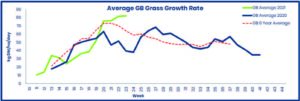For this season so far, Trouw have received around 500 first cut silages. This year, given the variation in weather, it is likely that there will be wide variation within and between crops on individual farms, highlighting the importance of accurate analysis. Growth continued throughout the winter, but then halted when we were hit with a slightly later period of low temperatures, coupled with no sunlight and even drought in some areas. April also saw the most frost in 60 years (Met Office) which led to a different growth pattern (Figure 1). This left a difficult decision for many as to whether to cut earlier and take a lighter crop or to wait and risk a more mature, but higher yield.

Early 1st Cut Results
The fermentation quality of the 1st cut samples is good with moderate pH and lactic acid and mostly low sugars. DM is reported at 33.7% DM, like last season, however ME is higher at 11.7 MJ/kg DM. Low protein in fresh grass samples has also been reflected in the silage, with protein averaging 14.6% DM. Although this is a very similar average to last year, the range is much wider (7.5-22.4% DM). NDF has also been low, averaging 41% DM compared to 44% DM last year. This is not unexpected as the NDF Pre-Cut Tracker reported low NDF values for a prolonged period before rapidly rising above the threshold of 40% DM. Most of these earl 1st cuts will have been taken before the rise, although there was huge variation in samples from around the UK. Low NDF has also results in a low fibre index at 167.
Acid load is high this season due to the increased digestibility of the crop. Producers should look to support rumen health by supplementing with fibre sources because of the low fibre index combined with high acid load. Average DyNE is reported lower than previous seasons, at 6.03MH/kg DM. This is due to variation in samples, lack of fibre and some higher lignin values.
Total Fermentable Carbohydrates (TFC) are much lower as a result of lower fibre levels. This balance of fermentability is also reflected in the NFEPB value. Variation in NFEPB highlights balance between rapid and slow sources of carbohydrates and protein in the rumen. The positive average indicates that the average silage fermentable protein is slightly higher in comparison to fermentable carbohydrates and that some fermentable carbohydrates should be supplemented.
This is most likely to be required in the form of Slowly Fermentable Carbohydrates (SFC), feeds that are fermented in over 2 hours after the food is eaten, typically fibrous sources of feed. However, in some diets fermentable protein supplementation may well be required especially if balancing with maize silage and wholecrop.
Practical Considerations
• Ensure adequate rumen available protein and bypass protein, considering a balanced diet and the price of overall diet rather than price of individual raw materials or compound feed.
• Forage stocks may be low, coupled with low fibre forages so care must be taken to balance fibre sources in the diet,
particularly in the form of SFC.
• Include sources of fibre to promote buffering and rumen function, but also monitor high acid load in the total diet and consider whether rumen fermentable or bypass sources of carbohydrate are needed, or a rumen buffer.
• Look to balance NFEPB and keep to below 200g/day of microbial protein.
For more advice and information on maximising your herds potential, please speak to your local NWF Sales Specialist.

